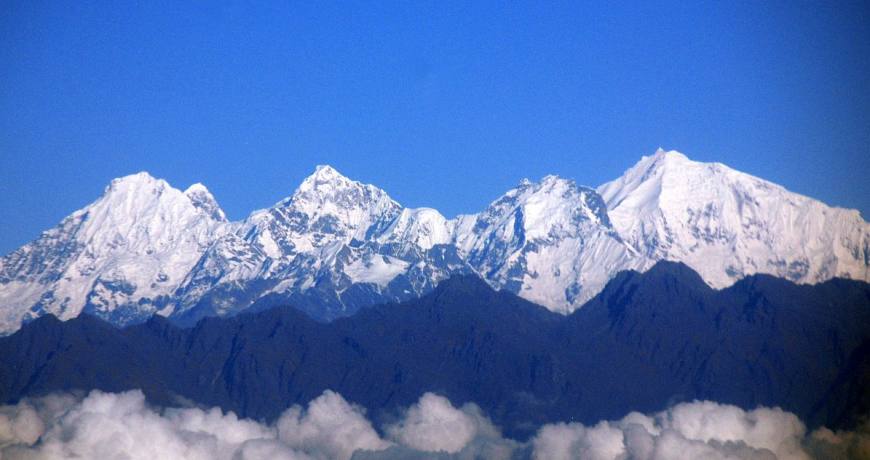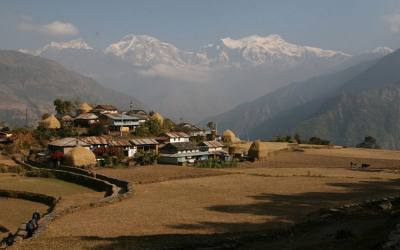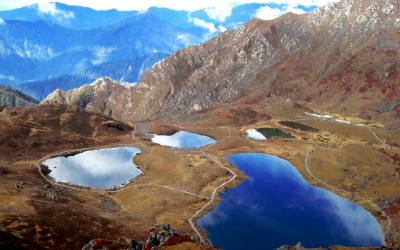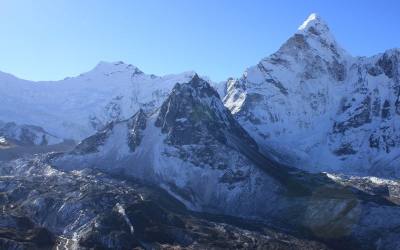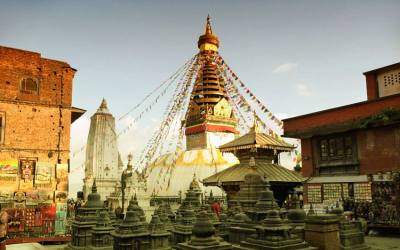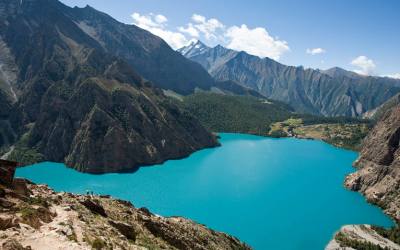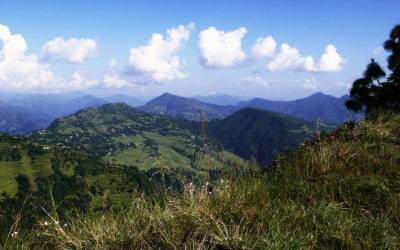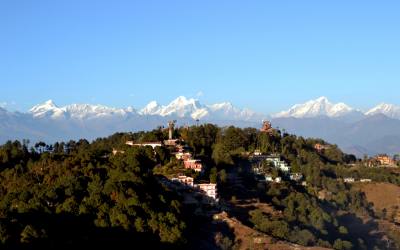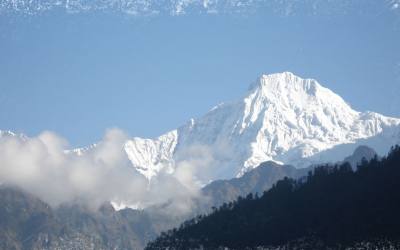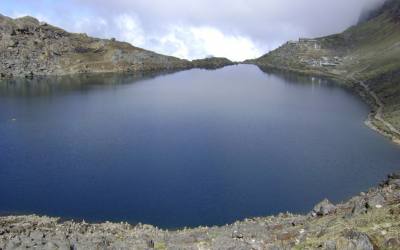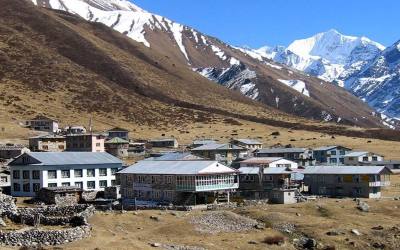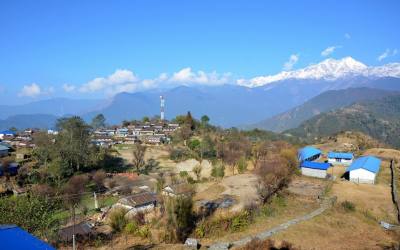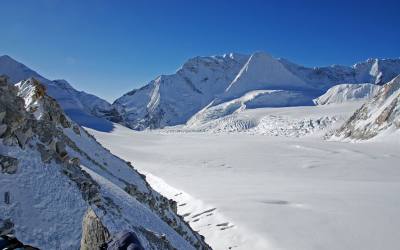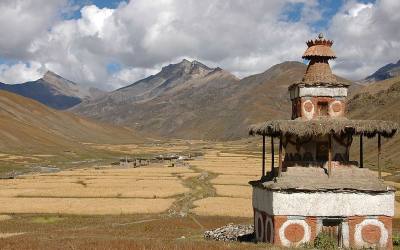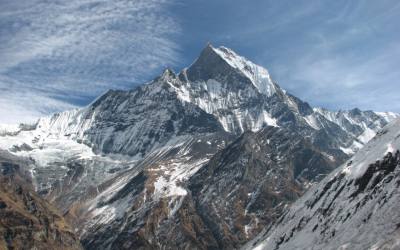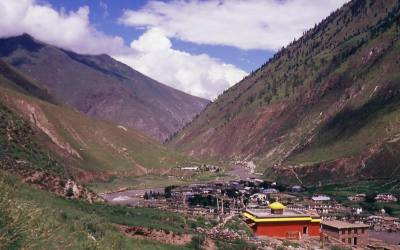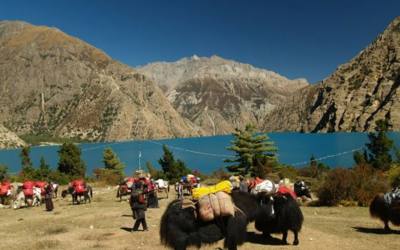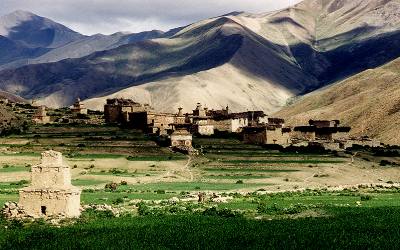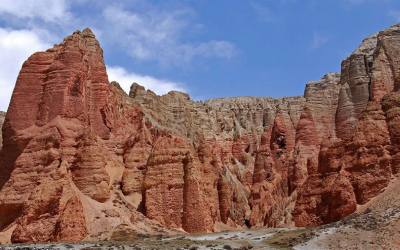Ganesh himal is to the west of Langtang Himal and east of Manasulu range. It stretches between the two rivers Trisuli and Budhigandaki. ganesh himal langtang trekThe main peak is Ganesh himal 7429m. the region has altogether 7peaks and all has its distinctive character. These mountains became famous since they can be seen from Kathmandu.it is one of the precious areas where the simple life of Himalayas can be still observed. The charm of this area is that it offers quite but variegated trekking, visiting some peaceful villages of Tamangs, hot spas, gorges and glaciers..
The course starts from Trisuli bazaar, in the semitropical sun, goes up to a fairly high elevation, where a close view of Ganesh 7163m.can be enjoyed, and descends to Syaprubesi after crossing over two passes. The highest elevation is more than 4000m.
The Langtang Himal is a region north part of Kathmandu. vally and it lies just south of Tibetan border. The langtang valley is sourrounded by high peaks of great appeal. It has become famous ever since the British mountaineer Bill Tilman described it as the most beautiful valley in the world. The highest peak in this area is Shisapangma or Gosaithan 8027m in Tibet. The course from the Langtang valley to Gosaikund is full of diversity and it is attracting many tourists. The langtang valley is also know as the treasure house of Alpine plants. The whole valley is cover with flowers during the summer.
This high and isolated region is inhabited by Tamangs whose religious practices, language and dress are much more similar to Tibetan.
Itinerary.
Flora and Fauna
ganesh himal langtang trekThe forests of Helambhu region and Langtang area prime example of temperate and sub alpine vegetation. The dense oak and pine forests on the trail of particular interest. As usual , the rhododendrons from a spectacular display during the spring.
People and culture
ganesh himal langtang trekThe people here, are of Tibetan origin and call themselves sherpa although they are quite distinct from the sherpas of Everest region both in language and customs. Many Tamang people also inhabit this area, Tamangs are also orginated in Tibet but settled in Nepal considerably earlier than Sherpas.
Day 01: Arrival & Transfer to Hotel in the afternoon sightseeing around Thamel(Tourist Area) & Walking tour to Kathmandu Durbar Squire.
Day 02: Free day in kathmandu
Day 03: Kathmandu. to Trisuli Bazar
Day 04: Trisuli bazaar to Deurali Bhanjyang(1700m)
Day 05: Deurali to Bhaisi Kharka(2300m)
Day 06: Bhaisi Kharka to Kharani odar(2800m)
Day 07: Kharani odar to Singla pass(4600m)
Day 08: Singla pass to Pongsang pass (3800m)
Day 09: Rest day
Day 10: Pongsang pass to Somdang Phedi( 3300m)
Day 11: Somdang phedi to Gotlang (1800m)
Day 12: Gotlang village to Syaprubesi (1400m)
Day 13: Syaprubesi to Lama Hotel (2400m)
Day 14: Lama hotel to Langtang valley (3307m)
Day 15: Langtang to Khayanjing gompa(3800m)
Day 16: Khayanjing Gompa rest day
Day 17: Khayanjing Gompa to Lama hotel (2500m)
Day 18: Lama hotel to Thulo Syabru (2200m)
Day 19: Thulo Syabru to Dhunche (1950m)
Day 20: Dhunche to Kathmandu.
Day 21: Free day in Kathmandu
Day 22: Tour ends
Day 01: Arrival & Transfer to Hotel in Kathmandu.
Upon arrival in Kathmandu. Our airport representative will be waiting outside the airport terminal a few metres from the exit door. Please check your name at play card. He will bring you to hotel in kathmandu. The drive from the airport to the hotel is around 20 minutes.
Hanumandhoka (Kathamdnu Durbar Square):
It is the historic seat of royalty. The Durbar Square, with its old temples and palaces, epitomizes the religious and cultural life of people. It is here that kings of Nepal are crowned and their coronations solemnized. Interesting things to see here are, Taleju temple built by king Mahendra Malla in 1954 AD, the temple of Kal Bhairab , the god of destruction, Nautale durbar, the statue of King Pratap Malla, the big drum and the Jaganath temple. It was listed in the UNESCO world heritage monument list in 1979.
On the right hand corner, a large wooden lattice screen hides an enormous gilded face of Sweta Bhairab. The screen is removed only during the Indra Jatra festival.. there are also the Numismatic museum and Tribhuban museum inside the Hanuman Dhoka palace building . Photography is prohibited inside the museums. Both the mseums remain closed on Tuesday and government holidays.
Day 02: Free day in Kathmandu or self sight seeing tour ( option are)
Budhanilkantha:
About 8km north of Kathmandu at the base of Shivapuri hill is a remarkable huge statue of Lord Visnhu. Reclining on a bed of snakes.This is one of the masterpieces of stone sculptures of the Lichchhavi period. This fifth century statue is in the middle of a small pond and seems to float in water.
Swoyambhunath
This is one of the world‘s most glorious Buddhist Chaityas. It is said to be 2,000 years old. Painted on the four sides of the spire’s base are the all seeing eyes of Lord Budhha. It is 3Km west of Kathmandu city and it situated on a hillock about 77 m commands an excellent view of the Valley. This stupa is the oldest of its kind in Nepal. It was listed in the UNSCO world Heritage Monument List in 1979.
Pashupatinath Temple:
Situated 5km east of kathamandu, the temple of Lord Shiva, Pashupatinath, with two tired golden roof and silver door is considered one of the holiest for Hindus. Although only Hindus are allowed inside the temple, visitors can clearly see the temple and the activites performed in the Temple premises from the eastern bank of the Bagmati river. The Temple was listed in the UNESCO world heritage Monument List in 1979
Patan
The ancient city of Patan, lying 5 km southwest of kathmandu, is known as the city of fine arts, The city is full of Hindu temples and Buddhist monuments. The diversity of the medieval culture that allowed both Hinduism and Buddhism to flourish has left a rich legacy of impressive sightseeing in this city for today’s visitors.
Patan Durbar Square:
Situated in the heart of the city, constitutes the focus of visitor’s attraction. The square is full of ancient palaces, Temple and shrines, noted for their exquisite carvings. The Patan durbar Square consist of three main chowks or countryards, the Central Mul Chowk, Sundari Chowk and Keshar narayan Chowk, The Sundari Chowk holds in its center a masterpiece of stone architecture. The Royal Bath called Tushahity. It was listed in the UNESCO world Heritage Monument list in 1979.
Krishna Mandir:
Built in 1637 AD, the temple of Lord Krishaa holds a commanding position in the palace complex of Patan. It is supposed to be the first specimen of Shikhara style architecture in Nepal. It is the only temple in Nepal having 21 spires and is completely 21 spires and is completely mad of stone.
Day 03: Kathmandu. to Trisuli Bazar
It takes about 4hours drive from Kathmandu. to Trisuli bazaar . in afternoon visit a Nuwakot palace which was built by Prithivi Narayan Shah who reunified Nepal by 1786.
Day 04: Trisuli bazaar to Deurali Bhanjyang(1700m)
Soon after leaving the Trisuli bazaar cross the suspension bridge of samari khola . trek along the river through rice paddies, passing the small villages along the way you will reach to Deurali village. Which occupied by mixture tribes.along the route one can have a good view of Trisuli valley .
Day 05: Deurali to Bhaisi Kharka(2300m)
Move on from the Deurali towards to Salme village.trail continue uphill through forest to reach Bhaisi Kharka. The camp site is very beautiful ground.
Day 06: Bhaisi Kharka to Kharani odar(2800m)
Trail continues gradually uphill through bamboo, pine and rhododendron forest to reach to Kharani odar. Many different kinds of birds and wildlife can be seen.
Day 07: Kharani odar to Singla pass(4600m)
Since the journey is long and gain about 1200m of elevation. It is wise to leave early in the morning . the path will enter a thickly forested area with many fir trees and rhododendron and ascends will become more serious. Passing many Kharkas and small peaks you will get on the ridgeline from where you will see very good views of Langtang himal and ganesh himal at very close distance.
Day 08: Singla pass to Pongsang pass (3800m)
It is the pleasant walk with view of Ganesh himal and Langtang Himal
Day 09: Rest day
Day 10: Pongsang pass to Somdang Phedi( 3300m)
From this pass facing the deep valley of the Mailung Khola. Descends all the way to reach Somdang Phedi. The campsite will be around the square infront of the miner’s housings.
Day 11: Somdang phedi to Gotlang (1800m)
From somdang trail goes downhill towards to Yuri Kharka. After here, walking thorough in forest and small villages you will reach to Gotlang village
Day 12: Gotlang village to Syaprubesi (1400m)
It is an beautiful walk from Gotlang to Syaprubesi through road and villages. Tamangs are major tribes along the way.
Day 13: Syaprubesi to Lama Hotel (2400m)
Trail continues uphill through deep forest and Langtang Khola all the way to Lama Hotel.
Day 14: Lama hotel to Langtang valley (3307m)
After Lama hotel you will climb through a Rhododendron forest . the ground covered by moss. Trees have ferns and epiphytic orchids on them. It looks like semi tropical jungle.
Day 15: Langtang to Khayanjing gompa(3800m)
From Lngtang village climb up the road with stone walls and you will come to Chorten of Mani stones .you will see that Langtang Khola gets closer all the time and the valley becomes more open and wider.climb up the rocky moraine ahead and you will reach Khayanjing Gompa.
Day 16: Khayanjing Gompa rest day
Khayanjing Gompa is the last permanent settlement with a small Gompa and a cheese factory. Use it as a base for day hikes, exploring the upper valley try to climbing the small hill north of Khayanjing or Tsergori(5033m). which lies upvalley from Khayanjing. Upper valley is ringed by spectacular snow peaks including fluted peak Langtang Lirung and the Tibetan named Dorje Lakpa.
Day 17: Khayanjing Gompa to Lama hotel (2500m)
After rest day Trail continues down hill till Lama hotel.
Day 18: Lama hotel to Thulo Syabru (2200m)
Path continues down hill till Langtang Khola. After lunch climb uphill for two hours to reach Syabru village.
Day 19: Thulo Syabru to Dhunche (1950m)
Trail descends through forest till Barkhu village. After Barkhu walking in road for one hour to reach Dhunche.
Day 20: Dhunche to Kathmandu.
Bus ride will take about 9 hours to reach Kathmandu.
Day 21: Free day in Kathmandu or self sight seeing ( option are)
Bhaktapur
Situated at an altitude of 1,401m, Bhaktapur covers an area of four square miles. Bhaktapur or the city of Devotees still retains a medieval charm and visitors to this ancient town are treated to myriad wonders of cultural and artistic achievements. The past glory of the Malla rulers continues to be reflected at the Durbar Square. Pottery and weaving are its traditional industries. Bhaktapur is famous for woodcarving and the Bhadgaolen topi or cap. The city lies about 14 km east of Kathmandu and can be reached by public transport and by trolley buses.
Bhaktapur durbar Squares:
The Golden Gate is the entrance to the main courtyard of the Palace of 55 Windows.Built by King Ranjit Malla. The gate ganesh himal langtang trekis one of the most beautiful and richly carved specimens of its kind in the entire world. This gate is embellished with deities and monsters with marvelous intricacy. The palace of 55 windows was built in 1700 AD. Among the brick walls in their gracious setting and sculptural design, is a balcony of 55 windows. This balcony is a masterpiece of wood carving. The stone temple of Batsala Devi which is also located in the Durbar Square is full of intricate carvings. This temple also sets a beautiful example of Shikhara style architecture in Nepal. There is a bronze bell on the terrace of the temple which is also known as the Bell of Barking Dogs.
This colossal bell, placed in 1737 AD, was rung to signal curfew those days.
The main square of the city contains innumerable temples and other architectural showpieces like the Lion Gate, the statue of King Bhupatindra Malla, the Picture Galley, the Batsal Temple, etc. A magnificent statue of King Bhupatindra Malla in the act of worship is placed on the column facing the palace. It was listed in the UNESCO World Heritage Monument list in 1979.
Changu Narayan:
Situated at the end of a long ridge which runs well into the Valley, It is said to have been built by king Hari Dutta in 323 AD said to be the oldest temple in the valley. It was listed in the UNESCO world Heritage Mountain list in 1979
Day 22: Tour ends
What’s Included
- Airport Pickup and Drop by private transport
- All the trekking transfer by local bus ( private transport will cost extra)
- 4 nights hotel in Kathmandu at tourist standard hotel ( centrally located, attach bathroom, hot and cold shower)
- All the meal during the trek (Breakfast, Lunch, Dinner)
- 9 nights 10 days sleeping in Tent
- 8 night accomodation at lodge ( simple but clean enough and has a hot and cold shower)
- Langtang national park permit and Tims card ( we need two photos each for permit)
- All the camping equipment such as sleeping tent, Dinning tent, kitchen tent, toilet tent, sleeping mattress, Sleeping Bag and necessary Kitchen Equipment etc.)
- An experience trekking guide (trained by Ministry of tourism), trekking cook, kitchen helper, sherpa and necessary number of porter’s . their meal/accommodation/transportation/salary/insurance/equipments are included in price.
What’s not Included
- Personal bar bill, travel insurance/International airfare/Domestic airfare.
- Items of personal expenses such as alcoholic drinks, cold drinks, laundry, tips etc.
- Nepal entry visa fee US$ 40 (duration 60 days from date of issue)- Available at Royal Nepalese Embassies and Royal Nepalese Consulates abroad or on arrival at Tribhuvan International Airport in Kathmandu.
- All the entrance fees of temple in Kathmandu and sight seeing tour
